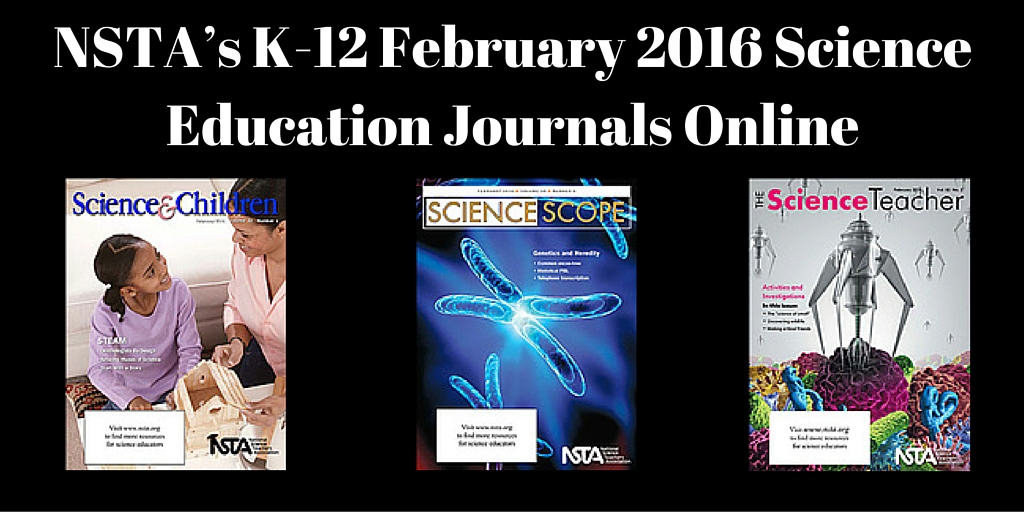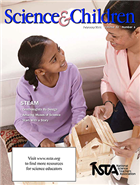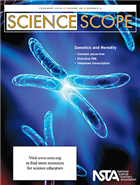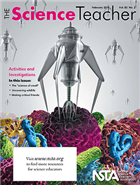NSTA’s K-12 February 2016 Science Education Journals Online
By Korei Martin
Posted on 2016-02-01
Looking to take advantage of the creative approaches that STEAM offers students? Want to explain to your students how traits are passed down from one generation to another? Are your students fascinated with nanoscience? The February K–12 journals from the National Science Teachers Association (NSTA) have the answers you need. Written by science teachers for science teachers, these peer-reviewed journals are targeted to your teaching level and are packed with lesson plans, expert advice, and ideas for using whatever time/space you have available. Browse the February issues; they are online (see below), in members’ mailboxes, and ready to inspire teachers!
The addition of the arts to science, technology, engineering, and math (STEM) adds a new dimension to lessons. As you’ll find in this issue of S&C, STEAM brings forth creative approaches to STEM that will enhance student learning, from brainstorming to communication skills.
Featured articles (please note, only those marked “free” are available to nonmembers without a fee):
- Amazing Muses of Science
- Free – Editor’s Note: STEAM: Beyond the Acronym
- Luminous Lighting
- Ornithologists By Design
- Free – Planning NGSS-Based Instruction: Where Do You Start?
- Start With a Story
- Table of Contents
When looking for information on genetics and heredity, X or Y can mark the spot to start your search. Dig into the activities in this issue to learn more about how traits are passed from one generation to the next. We are sure you will uncover a valuable lesson or two among the trees, peas, and telephone chatter.
Featured articles (please note, only those marked “free” are available to nonmembers without a fee):
- Controversial Environmental Issues Explored Through Interdisciplinary Perspectives: The Case of the Bald Eagle, the Botanical Garden, and the Airport
- Free – Editor’s Roundtable: Teaching Heredity and Evolution in the Next Generation
- From Mendel to Me: Constructing Genetics Knowledge Through Historical Problem-Based Learning
- Pass the DNA, Please
- Free – Planning NGSS-Based Instruction: Where Do You Start?
- Using Local Street Trees to Teach the Concept of Common Ancestry
- Table of Contents
Nanoscience development affects almost every discipline of science, engineering, and technology. Not surprisingly, “the science of small” is also finding its way into science classrooms. In general, nano refers to a billionth of a meter—about 1/50,000 the width of a hair follicle. The term nanoparticle usually refers to small materials with a size of between 1 and 100 nanometers (nm). Because nanoparticles are so small, they have a greater surface-area-to-volume ratio, causing them to be more reactive than larger particles and useful for various applications. Nanoscience is just one of many activities and investigations covered in this issue, which also looks at wildlife cover boards, using socio-scientific issues to teach argumentation, and finding patterns in chemical compounds.
Featured articles (please note, only those marked “free” are available to nonmembers without a fee):
- A Virtuous Cycle
- Free – Editor’s Corner: Write for The Science Teacher
- Making Critical Friends
- Free – Planning NGSS-Based Instruction: Where Do You Start?
- Shedding Light on the “Science of Small”
- Uncovering Wildlife
- Table of Contents
Get these journals in your mailbox as well as your inbox—become an NSTA member!
The mission of NSTA is to promote excellence and innovation in science teaching and learning for all.
Follow NSTA
Disclaimer: The views expressed in this blog post are those of the author(s) and do not necessarily reflect the official position of the National Science Teaching Association (NSTA).





